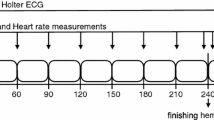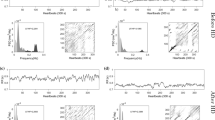Abstract
Previous studies have reported that anemia is a frequent occurence in patients with severe autonomic failure, that it can be corrected by exogenous erythropoietin and that upright blood pressure improves while on erythropoietin. The objective of this study was to determine the alteration of autonomic control during erythropoietin therapy in a patient with severe autonomic failure and severe symptomatic orthostatic hypotension, evaluated by spectral analysis of heart rate variability. The autonomic response to standing was evaluated before, after 1 month and after 6 months of erythropoietin therapy. The results were compared to an age- and sex-matched control adult. There was no improvement in the orthostatic hypotension during and at the end of the erythropoietin treatment despite an increase in hemoglobin from 9.6 g/dl before treatment to 12.5 g/dl during treatment. The spectral estimates of heart rate variability displayed a low variability at baseline, a paradoxical vagal enhancement and a lack of sympathetic increase on standing (before, during and at the end of the treatment). There was no improvement of baseline activity, nor of the response to standing during and at the end of the treatment with erythropoietin. We conclude that erythropoietin did not improve the autonomic response to standing, although it corrected anemia. Erythropoietin did not alter sympathetic activity, as reflected in the low frequency content of the power spectrum of heart rate fluctuations during and at the end of treatment.
Similar content being viewed by others
References
Thomas JE, Shirger A, Fealey RD, Shaps SG. Orthostatic hypotension.Mayo Clin Proc 1981;56: 117–125.
Bradshaus MJ, Edwards RTM. Postural hypotension — pathophysiology and management.Q J Med 1986;231: 643–657.
Onrot J, Goldberg MR, Hollister As, Biaggioni I, Robertson RM, Robertson D. Management of chronic orthostatic hypotension.Am J Med 1986;80: 454–464.
Ahmad RAS, Watson RDS. Treatment of postural hypotension — a review.Drugs 1990;39: 74–85.
Hoeldtke RD, Streeten DHP. Treatment of orthostatic hypotension with erythropoietin.New Engl J Med 1993;329: 611–615.
Perera R, Isola L, Kaufmann H. Effect of recombinant erythropoietin on anemia and orthostatic hypotension.Clin Auton Res 1995;4: 211–213.
Akselrod S, Gordon D, Ubel FA, Shannon DC, Berger AC, Cohen RJ. Power spectrum analysis of heart rate fluctuation: a quantitative probe of beat-to-beat cardiovascular control.Science 1981;213: 220–222.
Akselrod S, Gordon D, Madwed JB, Snidman NC, Shannon DC, Cohen RJ. Hemodynamic regulation: investigation by spectral analysis.Am J Physiol 1985;249: H867–875.
Keselbrener L, Akselrod S. Selective discrete Fourier-Transform algorithm — SDA — for time frequency analysis. Method and application on simulated and cardiovascular signals.IEEE Trans Biomed Eng 1996;43: 789–802.
Akselrod S, Oz O, Grinberg M, Keselbrener L. Dynamic autonomic response to change of posture investigated by time-dependent heart rate variability among normal and mild-hypertensive adults.J Auton Nerv Syst 1997;64: 33–43.
Shannon DC, Carley Dw, Benson H. Aging of modulation of heart rate.Am J Physiol 1987;253: H874–877.
Grubb BP, Samoil D, Kosinski D, Wolfe D, Lokten M, Madu E. Fluoxetine hydrochloride for the treatment of severe refractory orthostatic hypotension.Am J Med 1994;97: 366–368.
Bradbury S, Eggleston C. Postural hypotension: a report of 3 cases.Am Heart J 1925;1: 73–86.
Editorial. Management of orthostatic hypotension.Lancet 1987; 197–198.
Mann S, Altman DG, Raftery EB, Bannister R. Circadian variation of blood pressure in autonomic failure.Circulation 1983;68: 477–483.
Robertson D, Goldberg MR, Hollister AS, Wade D, Robertson RM. Clonidine raises blood pressure in severe idiopathic orthostatic hypotension.Am J Med 1983;74: 192–199.
Schirger A, Sheps SG, Thomas JE, Fealey RD. Midodrine — a new agent in the management of idiopathic orthostatic hypotension and the Shy-Drager syndrome.Mayo Clin Proc 1981;56: 429–433.
Kaufmann H, Brannan T, Krakoff L, Yahr MD, Mandell J. Treatment of orthostatic hypotension due to autonomic failure with a peripheral alpha-adrenergic agonist (midodrine).Neurology 1988;38: 951–956.
Jankovic J, Gilden JL, Hiner BC et al. Neurogenic orthostatic hypotension: a double-blind placebo-controlled study with midodrine.Am J Med 1993;95: 38–48.
Biaggioni I, Robertson D, Krantz S, Jones M, Haik V. The anemia of primary autonomic failure and its reversal with recombinant erythropoletin.Ann Intern Med 1994;121: 181–186.
Author information
Authors and Affiliations
Rights and permissions
About this article
Cite this article
Keselbrener, L., Korzets, A. & Akselrod, S. Failure of erythropoietin treatment in a case with primary autonomic failure. Clinical Autonomic Research 7, 333–336 (1997). https://doi.org/10.1007/BF02267727
Received:
Accepted:
Issue Date:
DOI: https://doi.org/10.1007/BF02267727




